Do you long for the picturesque scenery of idyllic landscapes? This China tour will give you a unique experience. In our China Escorted Tour from Beijing, you will visit the Forbidden City, Summer Palace, and other palace buildings in Beijing, and give you a glimpse of the superior and luxurious life of the ancient Chinese royal family. Then there is the China Escorted Tour with Yunnan. Here you will see the beauty of the rice terraces in their thousands of forms. The terraced rice paddies stretch from the base to the top of the mountain. The large terraces are covered in clouds and mist, like a ladder from earth to heaven, which is spectacularly beautiful. During our China Escorted Tour with Lijiang, we will walk through the Lijiang Ancient Town, explore the ancient buildings, and experience the traditional food and costumes of the region. We are sure you will get a different experience during our 15-day tour to China.

Welcome to China! Today, you will meet your tour guide at the airport and then be transferred to the local hotel to have a good rest. In the first three days, we will visit some famous attractions in Beijing. Beijing is the capital of China and is also the political, cultural, and technological innovation center of China. It has a population of over 20 million and a total area of 16,410 square kilometers. As an ancient city with a history of over 3,000 years, Beijing is the embodiment of Chinese civilization. In your Beijing escorted tour, we will come to see Tian’anmen Square, the Forbidden City, the Great Wall, and so on. I’m sure that you will be deeply impressed by the magnificent architecture and rich history and culture of Beijing.
Today, after you finished your breakfast, you will visit Tian’anmen Square first. Tian’anmen Square is located in the center of Beijing, covering an area of 440,000 square meters. As the world’s largest city center square today, it can accommodate one million people for a grand gathering.
In the Ming (1368-1644) and Qing (1636-1912) dynasties, Tian’anmen Square was a royal square, surrounded by palace walls with only three gates. Inside the three gates, a closed T-shaped palace square was formed, which was the place where the emperors of the Ming and Qing dynasties issued edicts. In case of national celebrations, the new emperor’s enthronement, the emperor’s marriage, and the appointment of the empress, it was necessary to issue an imperial edict here to let all officers know what’s happening. At that time, a platform would be established in the middle of the main halls. The Minister of Rites would receive the imperial edict in the Hall of Supreme Harmony. Then the imperial edict would be placed in a tray with dragon patterns (the dragon represented the emperor in ancient China) and be ascended to the Tian’anmen Gate Tower. Then it was placed on the imperial platform and read by the proclaiming officer. Civil and military officials were arranged according to rank in the south of the Golden Water Bridge (in front of the Tian’anmen Gate Tower), facing north and kneeling to listen. When the proclamation ceremony is finished, the imperial edict will be placed in the mouth of a carved wooden phoenix and tied with a yellow velvet rope. The officials of the Ministry of Rites kneeled to receive it with a tray with cloud patterns. The imperial edict would then be carried to the Ministry of Rites, transcribed on yellow paper, and distributed to all over the country for publication. The whole process of issuing the imperial edict of the feudal emperors was called the golden phoenix issuing the edict, which was very complicated, and the rules were strict, showing the majesty of the royal family.
Next, we will visit the Forbidden City (closed each Monday), which was the imperial palace in the Ming and Qing Dynasties. It is the largest and most complete ancient wooden structure existing in the world. It was first built in the fourth year of Yongle Reign (1402) of the Ming Dynasty, and a total of 24 emperors ruled the country here for more than 500 years.
As the highest center of power in China for more than five centuries, the Forbidden City, which includes landscaped gardens and a vast complex of 9,000 rooms housing furniture and artifacts, has become a priceless historical relic to Chinese civilization during the Ming and Qing Dynasties. The most important palace in the Forbidden City is the Hall of Supreme Harmony and its square, where the royal family held grand ceremonies. Hall of Supreme Harmony, commonly known as the Golden Palace, was built in 1420. It is decorated with many carved dragons in various poses. By the way, the dragon was the symbol of the emperor and can only be used by the emperor at that time. The buildings here reflect the idea of the supremacy of imperial power.
After lunch, your guide will take you to visit the Temple of Heaven where the emperors in the Ming and Qing Dynasties worshipped heaven. With an area of about 2.7 million square meters, the Temple of Heaven is the largest surviving ancient building complex for worshiping heaven in the world. A wonderful attraction in the Temple of Heaven is the Circular Mound Altar. When you stand on the stone slab in the center of the altar and shout, you will hear a bright echo from all directions. So people have given it a mysterious name - Heavenly Center Stone. Besides, around the Imperial Vault of Heaven, there is a wall of about 0.9 meters thick, named Echo Wall. When you stand at one side of the wall whispering, people standing at the other side will be able to hear you clearly as long as one of his ears is against the wall. It is the magic of Echo Wall and proves that 500 years ago, the Chinese already applied the principle of acoustics to architecture.
Our last stop is the Summer Palace, an imperial garden in the Qing Dynasty. It is a large landscape garden based on Kunming Lake and Longevity Hill, modeled on the West Lake in Hangzhou, Zhejiang Province, and designed with the garden styles of southern China. It is also one of the best-preserved royal gardens and is known as the Royal Garden Museum. When you enter the Summer Palace, you will see the very famous Long Corridor, which is the longest corridor in the world, being included in the Guinness Book of World Records in 1990. This corridor is more than 700 meters long and divided into 273 parts. Each part has many colorful paintings on the beam, including figures, flowers, and animals. There are more than 14,000 vivid and colorful paintings in total. Walking along this corridor, you can feel the relaxed state of mind of the royal family when they were on vacation here.
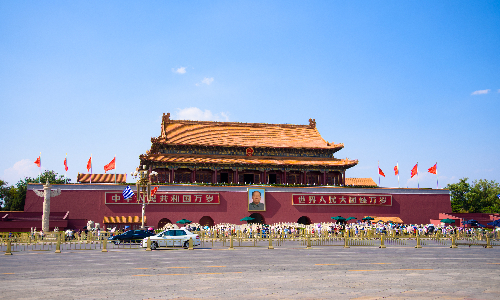
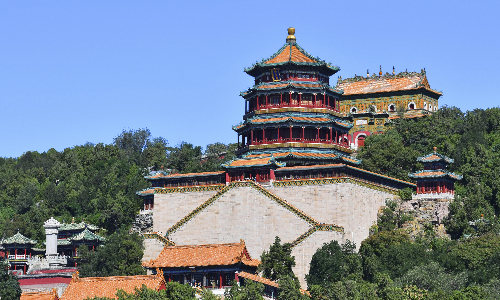
This morning, we will drive northwest for about one hour to the Sacred Way of Ming Tombs, 50 kilometers away from the center of Beijing. The Sacred Way is the leading part of the mausoleum building of Chang Tomb, with a total length of about 7.3 kilometers. The construction was completed in 1540 during the Ming Dynasty. This road, which runs from south to north, has many statues and buildings such as the Marble Archway, Three-hole Bridge, Great Palace Gate, and Stone Statues.
Going through the Sacred Way, we will continue to visit the Ding Tomb of Ming Tombs. Built between 1584 and 1590, Ding Tomb is the tomb of Emperor Wanli, the thirteenth emperor of the Ming Dynasty, and his two empresses. As the only excavated tomb of the Ming Tombs, many precious silks, jade, and gold artifacts have been unearthed here.
In September 1956, a Gold Crown of Emperor Wanli was unearthed at the Ding Tomb. It embodies the highest filigree inlay craftsmanship of the Ming Dynasty and was a beloved object of Emperor Wanli, only used when attending grand ceremonies. The crown weighs 826 grams and is made entirely of 518 gold wires of 0.2 mm in diameter, with a uniform mesh, no joints, and no broken wires. What’s more, it is as light as cicada wings. The crown was made in 16 stages, and the process was elaborate and time-consuming. It is no wonder that Emperor Wanli treated it as a treasure. Even when he was buried, he had to bring it into his tomb and place it next to his head.
In the afternoon, we will take you to the Juyong Pass Great Wall, one of the most famous passes of the Great Wall, with extremely dangerous terrain. It was built on mountains. It has been a barrier in the northwest of Beijing since ancient times. There is a beautifully carved white marble platform called Cloud Platform. During the Yuan Dynasty (1271-1368), the Juyongguan area was an important transportation route from Beijing to Inner Mongolia. As the emperor often passed through, there were palaces, temples, gardens, and other buildings around the pass. The existing Cloud Platform is the foundation of the street-crossing pagoda (a kind of Tibetan-Buddhism pagoda) built during the Yuan Dynasty. In the arched door, the stone walls are carved with the Four Heavenly Kings in an impressive posture, as well as Buddhist scriptures in Sanskrit, Tibetan, Mongolian, Uyghur, Tangut, and Chinese. The ground under the platform is paved with nearly 120 giant boulders, which have been worn smooth and stepped by pedestrians and horses passing through the arched door for hundreds of years.
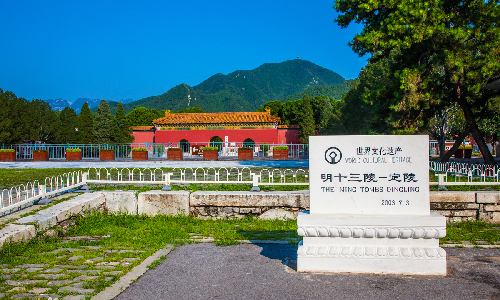
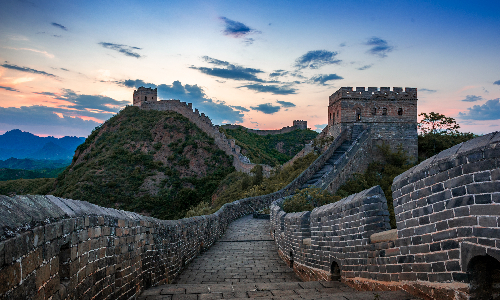
 Kunming
Kunming Today, we are going to leave Beijing and head to Kunming by air. The estimated flight will be CA1475 8:15/11:50. When you arrive, your local guide will pick you up at the airport. And then, we will drive southeast for about 80 minutes to the Stone Forest, about 85 kilometers from the airport. The Stone Forest, located east of Kunming, is a masterpiece of nature and a must-see in your Yunnan escorted tour. This 400-square-kilometer area is dotted with hundreds of huge black forest-like stones. Some of them are independent, and others intertwined. The stones standing on the ground are in various shapes. The Stone Forest is a masterpiece of the earth’s evolution, having undergone 300 million years of changes. The original limestone was formed in the sea. Later, as the earth’s crust changed, the sea became land; the land became mountains; the limestone was unbelievably shaped into the Stone Forest landscape. During this time the forest was also baked by hot volcanic lava and flooded by vast lakes. Therefore, the formation of the Stone Forest is a true geological saga.
Leaving Stone Forest, your guide will bring you to the hotel in Shilin County. You can have a good rest tonight, and tomorrow we will have our new journey.
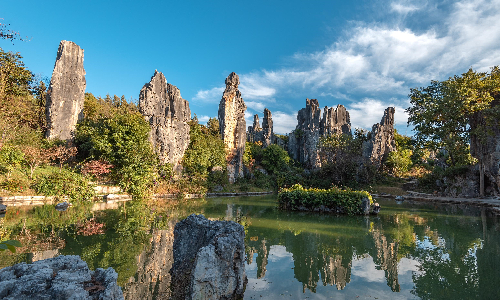
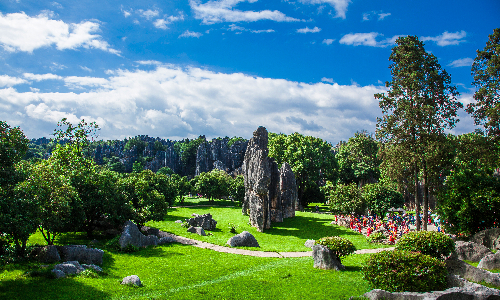
 Jianshui
Jianshui This morning, you need to pack your luggage after you finished your breakfast because we will go to Jianshui and overnight there. We will drive southward for about two and a half hours to Jianshui County, about 200 kilometers away. Our first stop in Jianshui is Chaoyang Tower, where you can have a bird’s eye view of the ancient town of Jianshui. Chaoyang Tower was established in 1389 in the Ming Dynasty and it is a symbolic old town in Yunnan Province. We will walk into the Ying Hui Gate of Chaoyang Tower, which is wide enough for two cars to run parallel. We will then climb up the tower and stand on it to overlook the Jianshui Ancient Town. The wood-carved door on the tower is exquisitely made, and a large bronze bell is on the east side of the tower.
Walking north along Ying Hui Road, we will then visit the Jianshui Ancient Town, which has been a major town in southern Yunnan since ancient times, with unique ancient houses, walls, and bridges. Strolling along the streets of the old town, you can still appreciate the glorious Jianshui of the past. After 12 centuries of construction, there are more than 50 ancient buildings in the old city, which are known as the Museum of Ancient Architecture.
Next stop, we are going to visit the Confucius Temple. Jianshui Confucius Temple was built in 1285 AD with a history of more than 700 years. The Confucius Temple was built to commemorate Confucius, the great thinker and educator of China. Confucius temples are founded all over the country, and hundreds of them are well-preserved today. The Confucius Temple in Jianshui is the third-largest Confucius Temple that is well-preserved today. Legend has it that after the Yuan Dynasty’s army destroyed the Southern Song Dynasty (1127-1279), they deliberately relegated a large number of its officials to Jianshui, a small frontier town thousands of miles away so that they could never restore their country. However, the literature here flourished as a result. During the Yuan and Ming Dynasties, the temple and the academies were built here, thus Jianshui was full of talents, and sometimes half of the students who passed the imperial examination came from here. When you come here, you will see the temple is surrounded by ancient cypresses, looking solemn and majestic.
Of course, in addition to the Confucius Temple, among the many old buildings in Jianshui Ancient Town, the Zhu Family Garden is well worth seeing. Zhu Family Garden is a private residence and ancestral hall built by the brothers of Zhu family, who were local squires during the late Qing Dynasty. The building covers an area of more than 20,000 square meters, with orderly houses and courtyards. The whole group of buildings is beautiful and elegant. As a typical home garden with southern China characteristics, it combines the Chinese inland culture and frontier culture and has high architectural art value.
After leaving the Zhu Family Garden, you will be transferred to the hotel we prepared for you and have a good rest.
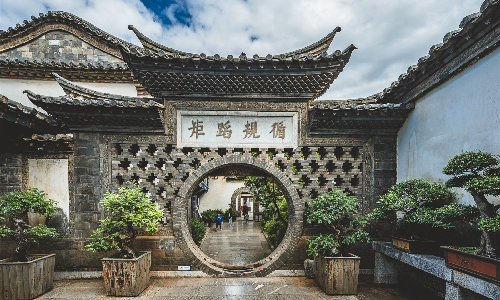
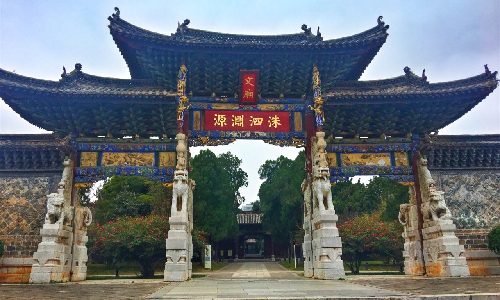
 Yuanyang
Yuanyang This morning, we will leave Jianshui and head to Yuanyang. We will drive southward for about three hours to visit the Yuanyang Rice Terrace, 123 kilometers from Jianshui County. Yuanyang Rice Terrace is a masterpiece left behind by the Hani people for generations. The Hani people’s ability to cultivate the rice terraces is excellent, as they have adapted to the local conditions, cultivating large fields where the slopes are gentle and large, as well as small fields where the slopes are steep and small. A casual glance at this area will make you notice a varied landscape of terraces. The water here is illuminated by the white clouds and blue sky, and the trees and the mountains are like a beautiful painting. When the sun comes out, the terraces are like a huge palette of colors, blending red, green, blue, and yellow to create a multitude of colorful canvases along with different rays of light.
In the afternoon, we will continue to visit the Bada Rice Terrace. Bada, translated from the Hani language, means wide-field dam or the place closest to the sky. As one of the main terraced scenic spots in Yuanyang, the Bada Rice Terrace is as vast as the sea and is a famous spot for watching sunsets, terraced rice fields, the sea of clouds, and Hani villages. The terraces are magnificent in size, with beautiful lines that give them a strong sense of three-dimensionality. From a high vantage point, the thousands of acres of the rice terrace look like a staircase stretching from the foot of the mountain to the top. The best part of visiting the terraces is the sunset. Every evening in winter and spring, the sunset reddens the clouds in the sky, and the glistening sunglow is reflected in the vast fields of Bada Rice Terrace. You must catch this wonderful scene when you visiting the Bada Rice Terrace in Yuanyang.
Tonight, you will live in the local hotel we prepared.
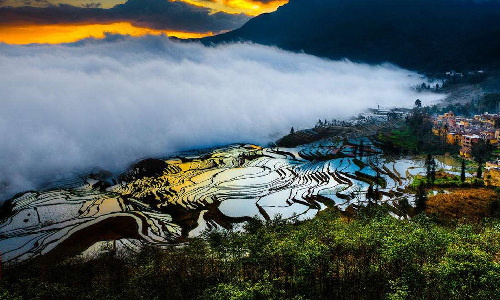
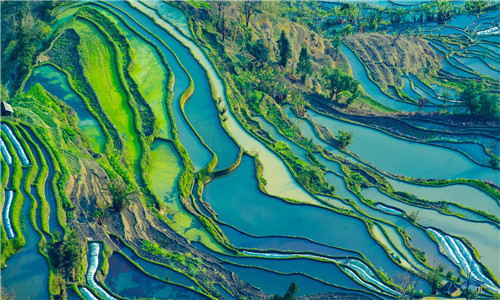
 Kumnming
Kumnming On the last day in Yuanyang County, we will go to the Hani Old Street Market. The Old Street Market is a local Hani farmers’ market that is bustling with activities. The market is an opportunity for the local Hani people to interact with each other and is a place for tourists to get a view of the Hani culture. The farmers’ market sells mainly grains, seedlings, fruits and vegetables, as well as caged piglets, chickens, and other meat. In addition, various local daily necessities can also be bought here, such as bamboo baskets and embroidered bags. There is also locally produced red rice grown in the rice terraces. At the farmers’ market, you will find some unusual vegetables, such as taro, which grows larger than usual, and purple yams. The rich cultural landscape and the atmosphere of minority life will make your trip much more meaningful.
After lunch, we will drive northward for about 4 hours to Kunming, 334 kilometers from the market we visited in the morning. When we arrive in Kunming, we will have a good rest at the hotel. Tomorrow we will start our new journey.

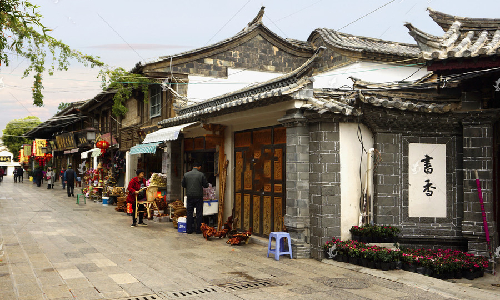
 Dali
Dali This morning, you will be transferred to the high-speed rail station to take the estimated train G8664 08:07/10:21 to Dali, a beautiful city in the south of Yunnan Province.
Our first stop in Dali is the Dali Ancient Town. It is located at the foot of the beautiful Cangshan Mountain, 13 kilometers from the center of Dali. The Dali Ancient Town was built in the 15th year of the Hongwu of the Ming Dynasty (1382). The old town is west of Erhai Lake and east of the Cangshan Mountain, with majestic buildings and beautiful scenery. The scale of Dali Ancient Town is huge, with a circumference of over 6,000 meters. Unlike the bustling and noisy city center, Dali Ancient Town is quaint and quiet. The main street runs north and south in the town, lined with stores selling marble products, tie-dyes, straw weavings, and other specialties. There are also restaurants with ethnic characteristics. In addition, clear streams flow through the town, and traditional Yunnan houses can be seen everywhere. All residents, whether rich or not, have flowers and plants in their courtyards. As a result, the ancient city of Dali is always lush and vibrant.
Then, we will go to see The Chongsheng Temple And The Three-Pagoda. The three ancient pagodas here are known as Dali’s landmarks and the testimonies of Buddhism prevailing in Dali. The main pagoda in the middle, also known as the Qianxun Pagoda, is 69.13 meters high with 16 floors and it was built during the Nanzhao Kingdom (738-902). The pagoda is a typical Dali square-shaped hollow brick tower with a wooden ladder circling up inside the pagoda center. The small pagoda in the north and south are both ten floors, 42.17 meters high, built in later times in the Dali Kingdom(1096-1253). The two small pagodas are 97 meters respectively and are octagonal hollow brick pagodas. The pagodas are decorated with relief carvings of Buddhas, lotus flowers and vases. Standing near the pagoda, you can feel the solemnity and grandeur of the ancient temple.
Next, we will visit Erhai Lake, the second-largest freshwater lake in Yunnan Province. Looking down from the sky, Erhai Lake looks like a crescent moon, lying quietly between Cangshan Mountain and Dali Dam Plain. It is a sag lake with crystal clear water, which has been called “a piece of flawless jade” since ancient times. You will have a boat tour on the lake.
At last, you will go to the hotel and check in.

 Lijiang
Lijiang This morning, we will drive northward from Dali for about two and a half hours to Lijiang. The whole journey is about 190 kilometers. On the way to Lijiang, we will pass by and visit the Xizhou Ancient Town. Xizhou Ancient Town has over 1,000 years of history, with the Erhai Lake to the east and the Cangshan Mountains to the south. As an important town of the Bai nationality, it has the most and best-preserved Bai residential buildings, fully reflecting the architectural talent and artistic creativity of the Bai people.
When you come here, you must try the delicacies, such as the Xizhou bread, and Yunnan Goat Cheese. Xizhou bread is made from wheat flour, spring onions, and minced meat, and is available in sweet and salty flavors. The Yunnan Goat Cheese is a fan-shaped dairy product that can be eaten raw, fried, or grilled and has a high nutritional value and a good flavor. It is one of the best dishes that the Bai people entertain their guests. In addition, the scenery is beautiful and the air is fresh all year round. Isn’t it rather wonderful to walk through the streets of the ancient town, admiring the beautiful scenery and the ancient buildings, and tasting the specialties of the area?
Leaving Xizhou Ancient Town, we will continue to drive northward until we arrive at the Lijiang Ancient Town. Lijiang Ancient Town is located on a plateau at an altitude of 2,400 meters at the foot of the Jade Dragon Snow Mountain and is one of the most famous historical and cultural sites in China. Sifang Street, located in the center of the ancient town, is well connected to many other streets. Surrounded by lanes and alleys, it was historically a place for trading goods and was the most important hub on the ancient Tea Horse Road. Since the Ming and Qing Dynasties, merchants have gathered here, and various ethnic cultures have intermingled here, making it the center of economic and cultural exchange in Lijiang. On both sides of the stone-paved road, all the houses are of brick and wood construction. Most of the doors, windows, arches, and eaves are carved with patterns of flowers, birds, insects, fish, etc. The houses coved with tiles are lined up one after another. So the ancient town is also known as a “residential museum” by Chinese and foreign architectural experts.
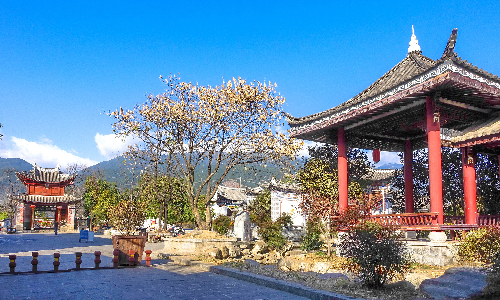
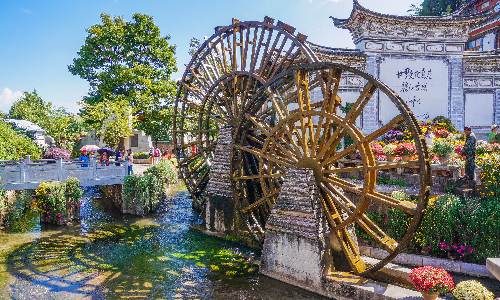
Today, we are going to visit the Baisha Village and see the murals there. The Baisha Village was once the political, economic, and cultural center of Lijiang and was also the original settlement of the people of Naxi nationality in Lijiang, preserving the original Naxi culture. It is said that more than 80 percent of the residents in Baisha Village are the original inhabitants, which is rare in Lijiang even in China. When you stroll in the village, you can sit down to have a cup of tea in the street shops and enjoy the Jade Dragon Snow Mountain in the distance.
During the Ming Dynasty (1368-1644), Lijiang was at the height of its political stability and economic prosperity. To show the wealth, governors built a large number of luxurious buildings here. The murals preserved in those buildings are extremely valuable cultural relics. The Baisha Murals are a blend of Chinese, Tibetan, and Naxi cultures, and showcase some stories of Tibetan Buddhism, Confucianism, and Taoism. With the rigorous brushwork, rich colors, and realistic figures, the Baisha Murals draw on the characteristics of the Dongba(religious culture of Naxi nationality) paintings. The murals cover a wide range of subjects, including galloping horses, blooming lotus flowers, mountains and fields, as well as birds and insects, all of which demonstrate the painter’s keen observational skills and active thinking. With its distinctive artistic style of painting and precious historical and cultural connotations, the Baisha Murals have captivated visitors from home and abroad.
After lunch, we will go to the Black Dragon Pool, located at the foot of the Xiangshan Mountain, with an altitude of 2,500 meters. It is a park with a history of hundreds of years, and famous for the crystal-clear pool of water here. Because of this clear pool, it has become one of the best places to see the reflection of Jade Dragon Snow Mountain. The water gushes out from the rocks, and the clear springs converge into a 40,000-square-metre pool. The Black Dragon Pool, with its beautifully shaped ancient buildings dotted around the mountain and water, has attracted people to visit from all over the world. Not far from the park, you can see the pavilions and towers scattered around the lake, with ancient buildings such as the Deyue Tower and the Suocui Bridge reflected in the lake and the snow-capped mountains standing in the distance, forming a beautiful landscape.
Then, we will go to the Dongba Cultural Museum (closed each Monday) to deeply know the traditional culture of the Naxi nationality in Yunnan. The Dongba Culture Museum is themed on Dongba culture, the traditional culture of the Naxi people, and introduces a comprehensive range of ethnic folklore including the history, nature, and art of Yunnan. The museum displays scenes of folklore and religious rituals such as the worship of the sky and the wind. In the museum, you can also see various pictures and papers about Dongba culture, as well as physical materials such as scriptures, paintings,ritual tools, and ancient utensils of the Naxi people, making it one of the best museums to see in Yunnan Province.

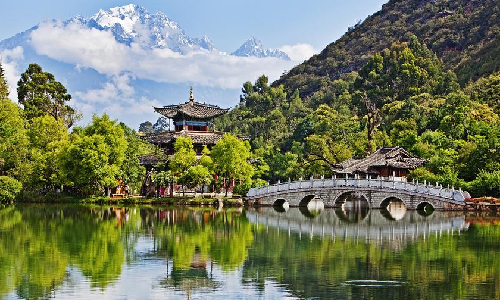
 Shangri-la
Shangri-la This morning, we will drive northwest for about three hours to Shangri-la, 175 kilometers away from Lijiang. On the way, we will visit two places before we arrive at our destination. The first stop of our escorted tour to Shangri-la is Stone Drum Town. Located in the western part of Lijiang, Stone Drum Town is named after a drum-shaped stone monument carved in white marble, which is one of the earliest stone monuments ever found in Lijiang. The town is also home to the famous First Bend of the Yangtze River. The Yangtze River rushes down from the Tibetan Plateau, the roof of the world, flows out of Qinghai Province, enters Yunnan through Tibet, and continues to flow south through mountains. When it reaches Stone Drum Town, it turns to the northeast, forming a huge “V” shaped bend, which is known as the First Bend of the Yangtze River.
Continuing driving northward, we will go to the Tiger Leaping Gorge next. Tiger Leaping Gorge is located in the upper reaches of the Jinsha River, with two snow mountains on both sides. The vertical height difference of the gorge is over 3900 meters, making it one of the deepest gorges in the world. The narrowest part of the river in the gorge is only about 30 meters, with a huge boulder in the middle of the river, splitting the torrent in two. Legend has it that a tiger once took advantage of this boulder in the heart of the river to leap from the side of the Jade Dragon Snow Mountain to the Haba Snow Mountain, so it was named Tiger Leaping Stone and the gorge was named the Tiger Leaping Gorge.
After leaving the Tiger Leaping Gorge, we will continue driving northward. When we arrive in Shangri-la, we will live in the local hotel we prepared for you to have a good rest.
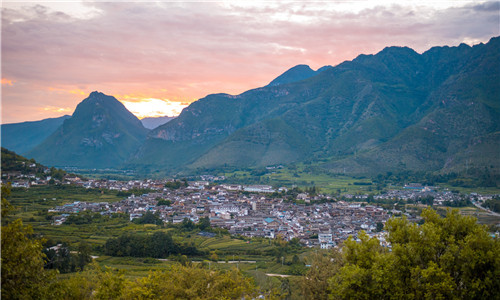

Today, in Shangri-la, we will see the Songzanlin Monastery, which is the largest Tibetan Buddhist monastery in Yunnan Province. Built on a hill, the monastery is like an ancient castle and is known as the Museum of Tibetan Art, as it is a masterpiece of Tibetan architectural art. The main hall of the monastery is majestic and gorgeous, and the murals inside are brightly colored and delicately painted to describe historical allusions and promote Buddhist teachings. The main hall faces south and is a five-story Tibetan-style building. It has gilded copper tiles on the upper floor, and the corners of the building have upturned eaves, with a Chinese style of temple architecture. The top floor of the main building houses sutras and Buddha statues, including the statues of the fifth and the seventh Dalai Lama, as well as thangkas, and Dharma vessels. The monastery can be said to be a collection of the essence of Tibetan religious culture.
After you finished your lunch, we will visit the Potatso National Park. With the Bita Lake and Shudu Lake as main parts, it is home to mirror-like alpine lakes, beautiful pastures, flower-filled wetlands, and pristine forests frequented by birds and animals. The two beautiful freshwater lakes here are known as the pearls of the plateau and are rich in different kinds of fish, which are quite delicious. In spring and summer, wildflowers bloom and birds flock to the area, making it an enchanting place to visit. In autumn and winter, the lakes are home to ducks and other birds of prey, making this national park more attractive. Strolling through the pastures, you will hear the horses’ tinkling neck bells from far away and see smoke rising from the tents in the distance. No matter what season you come for a visit, you will always see the picturesque scenery and enjoy the beauty of nature.
On the last day in Shangri-la, we will visit a Tibetan family here, which is an opportunity for you to know some traditional customs and specialties of Tibetan. As you enter the family, you will receive a Hada (a white scarf) from the host, which is a unique Tibetan tradition that shows respect and welcomes guests. You may taste many specialties here, such as ghee tea, barley wine, jacket potatoes, and cheese.
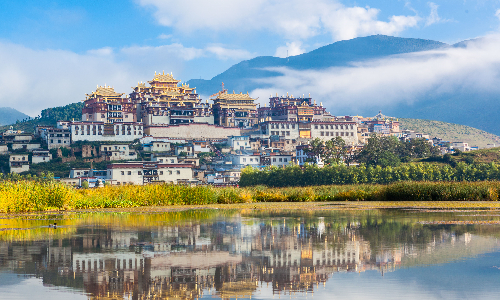
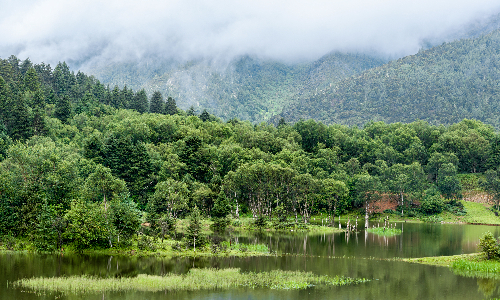
 Shanghai
Shanghai Today, you can arrange your time freely in the morning and pack up your luggage. In the afternoon, you will be transferred to the airport to take the estimated flight MU7891 15:55/21:55 to Shanghai, the last stop of your China tour. In your Shanghai escorted tour, we will take you to many special places to experience the magic and charm of this metropolis.
This morning, you will see the Jing’an Temple first. The first thing that comes to mind when you think of Shanghai is modern skyscrapers. In fact, Shanghai is an eclectic city. In the heart of Shanghai lies the Jing’an Temple, a thousand-year-old temple. Surrounded by skyscrapers and a constant flow of pedestrians, the ancient temple attracts people with its calmness and tranquility. As you enter, you will see an open space with a large incense burner. Surrounding the open space is the two-story gate tower, the Bell Tower and Drum Tower. The entire temple shines in the sunlight with its golden tile roof, the golden lion statue on the tall pillar in front of the gate and the pagoda at the back of the temple, all of which showcase Chinese Buddhist culture and architecture.
Next, we will visit the Yu Garden (closed each Monday). With a history of 400 years, it was a private garden built in the Ming Dynasty. The Chinese word Yu means peace and happiness. The owner built Yu Garden for the pleasure of his parents in their old age. There are more than forty ancient buildings in the Yu Garden, such as the Sansui Hall, the Deyue Tower, and the Water Gallery. Among them, Sansui Hall is one of the main buildings in the garden. In Chinese, Sansui means three ears of wheat. In ancient China, three ears of wheat meant a good harvest, hence the name Sansui Hall. You will also see that the eight windows at the main entrance of the hall are also carved with patterns of rice, corn, sorghum, and melons. It shows that the first owner of the garden wanted people to have a good life at that time.
After lunch, we will go up the Shanghai Tower to have a bird’s eye view of Shanghai. With a total construction area of 578,000 square meters, the Shanghai Tower is the tallest building in Asia with 127 floors on the ground and 5 floors underground, and a total height of 632 meters. Besides, the elevators here are also worth experiencing. The Shanghai Tower’s express elevator has a maximum speed of about 40 miles per hour and is the fastest elevator in the world. We can take the elevator and reach the 118th floor of the sightseeing platform in 55 seconds. If we go down, the speed is 10 meters per second, and we can reach the first floor in 70 seconds. Coming to visit here, you can overlook the beautiful Shanghai.
Then we will continue to visit the Bund, one of the most representative places in Shanghai. The Bund is 1.5 kilometers long. It was a center of financial and foreign trade in old Shanghai. In the 20th century, due to the development of architectural technology and economic strength, the Bund saw the emergence of multi-story and high-rise buildings in a variety of styles, such as British classical, British neoclassical, British Renaissance, and French classical, French residential, Gothic, Baroque, modern Western, East Indian, as well as Chinese and Western mixed style, showing the coexistence of architectures from all over the world. Therefore, this complex of buildings on the Bund is known as the Architecture of the World.
Finally, we will go to Nanjing Road, the busiest commercial street in Shanghai and a shopper’s paradise both at home and abroad. There are hundreds of long-established Shanghai stores, where you can buy souvenirs and enjoy a wide variety of authentic Shanghai food, like cookies, Cantonese-style dim sum, smoked fish and fresh meat mooncakes, all of which are must-tries for Shanghai locals. If you love shopping, this is definitely a must-visit destination in Shanghai.

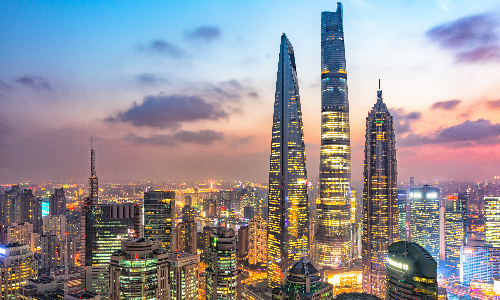
Today, you will prepare to leave China. After breakfast, you will be transferred to the airport and fly to your home. We hope that you have had a good time in China these days and welcome you to come again next time.
Editor: Fan Lin
Proofreader: Summer Hou
| City | Five Star hotel list | Four Star hotel list |
|---|---|---|
| Beijing | Sunworld Dynasty Hotel Beijing Wangfujing | Sunworld Hotel Wangfujing |
| Kunming | Grand Park Kunming | UChoice Hotel |
| Jianshui | Lin'an Hotel | Hanlinyuan Hotel |
| Yuanyang | Oness Resort Yuanyang Terrace | Oness Resort Yuanyang Terrace |
| Dali | The One Hotels & Resorts | Landscape Hotel |
| Lijiang | Wonderport International Hotel | Lijiang Wangfu Hotel |
| Shangri-La | Paradise Hotel | Ri Yue Xing Cheng Hotel |
| Shanghai | Ocean Hotel Shanghai | Ambassador Hotel |
 |
![]() About your child or infant, please contact us for a discounted price.
About your child or infant, please contact us for a discounted price.



We started with a few days in Beijing & ended in Shanghai, from where we visited the Forbidden City and Great Wall. In between we visited Terra Cotta Warriors Museum, Panda Base, Shanghai Disneyland.

We had a wonderful holiday in China which will remain long in the memory. China is a breathtakingly beautiful country full of splendid temples and palaces, mountains and rivers, peaceful rural scenes and bustling shopping streets.
 QUICK ENQUIRY
QUICK ENQUIRY